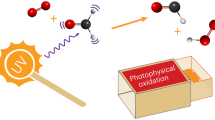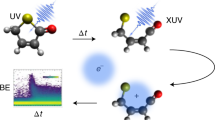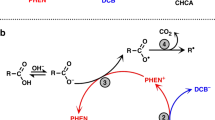Abstract
ATKINSON1 has accounted for the products of the mercury photosensitized decomposition of tetrafluoroethylene by supposing that the excited mercury atoms (Hg 3P1) are able to decompose tetrafluoroethylene to give two difluoromethylene radicals. This requires that the dissociation energy of the carbon–carbon bond in tetrafluoroethylene is equal to, or less than, 112 kcal./mole. Since this value is significantly smaller than the lower (125–30 kcal./mole)2 of many values suggested for the dissociation energy of the carbon–carbon bond in ethylene, it is of some interest to obtain independent estimates of the heat of formation of the difluoromethylene radical.
This is a preview of subscription content, access via your institution
Access options
Subscribe to this journal
Receive 51 print issues and online access
$199.00 per year
only $3.90 per issue
Buy this article
- Purchase on Springer Link
- Instant access to full article PDF
Prices may be subject to local taxes which are calculated during checkout
Similar content being viewed by others
References
Atkinson, B., J. Chem. Soc., 2684 (1952).
Cottrell, T. L., Bond Dissociation Energies, second ed. (Butterworths, London, 1956).
Beynon, J. H., Lester, G. R., and Williams, J. Phys. Chem., 63, 1861 (1959).
Bralsford, R., Harris, P. V., and Price, W. C., Proc. Roy. Soc., A, 258, 454 (1960).
Good, W. D., Douslin, D. R., Scott, D. W., Dawson, J. P., and Waddington, G., J. Phys. Chem., 63, 1133 (1959).
Scott, D. W., McCullough, J. P., Good, W. D., Messerley, J. F., Pennington, R. E., Kinchenloe, T. C., Hossenlop, J. A., Douslin, D. R., and Waddington, G., J. Amer. Chem. Soc., 78, 5457 (1956).
Neugabauer, G. A., and Margrave, J. L., J. Phys. Chem., 60, 1318 (1956).
Scott, D. W., Douslin, D. R., Messerley, J. F., Todd, S. S., Hossenlop, J. A., Kinchenloe, T. C., and McCullough, J. P., J. Amer. Chem. Soc., 81, 1015 (1959).
Atkinson, B., and Atkinson, V. A., J. Chem. Soc., 2086 (1957).
Atkinson, B., and Trenwith, A. B., J. Chem. Soc., 2082 (1953).
Duus, H. C., Indust. Eng. Chem., 47, 1445 (1955).
Reed, J. F., and Rabinowitch, B. S., J. Phys. Chem., 61, 598 (1957).
Mann, D. E., and Potocki, R. W., N.B.S. Rep., quoted in ref. 15.
Reed, J. F., and Snedden, W., Trans. Farad. Soc., 54, 309 (1957).
Margrave, J. L., J. Chem. Phys., 31, 1432 (1959).
Author information
Authors and Affiliations
Rights and permissions
About this article
Cite this article
MAJER, J., PATRICK, C. Heat of Formation of the Difluoromethylene Radical. Nature 192, 866–867 (1961). https://doi.org/10.1038/192866a0
Issue Date:
DOI: https://doi.org/10.1038/192866a0
This article is cited by
Comments
By submitting a comment you agree to abide by our Terms and Community Guidelines. If you find something abusive or that does not comply with our terms or guidelines please flag it as inappropriate.



